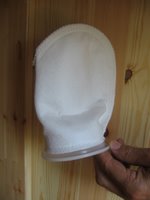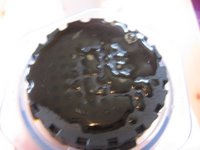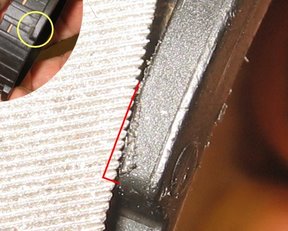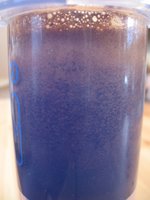The problem
The Aeropress gives its user unprecedented control over brewing variables, yielding a great cup of coffee. But there's trouble in paradise. It has a shortcoming. Fans of the venerable French press would understand immediately, because they are accustomed to a cup that offers the complex flavors of the coffee's natural oils. These are lost in paper filtration systems like the Aeropress. On the other hand, many people (like me) do not enjoy the fines that a French press delivers with the brew. They embitter the bottom of the cup as they cause overextraction there, and they have a bad mouthfeel. So we're caught between a rock and a hard place. To get one thing we like, we need to stomach something else we don't like. Or live without what we do like. Bother.
But there's a way out of this dilemma! Call it "better filter media."
For some background, see the photographs in this thread at coffeegeek.com, and here and here as well. A picture showing oils in the cup is here.
Edits to this page in green
The material
Five micron (nominal) polyester felt filtering media is some elegant material, and it's not very expensive. Anyone wishing to buy their own and cut 2.5" rounds to fit the Aeropress can enjoy 5 cent filters that can be used for a week or more. Available from many vendors, it's a bit harder to find FDA grade material that's sure to be free of surfactants and other manufacturing and processing contaminants. Even so, I've found that non-FDA grade material works suitably for filtering. Only recently have I switched exclusively to FDA grade material, but for a different reason that will be explained further on.
There are two main classes of filtering media that relate to practical coffee filtering. Paper and metal filters are surface filters, meaning that they have holes in them and the particles press up against the surface, and liquid passes through the pores in the material. Another class of materials filters at depth, which means the particles don't merely abut a surface and find they can go no further; rather, they get tangled in a web that has depth; they go as far as they can through a surface that provides a gradient of porosity that gets finer the deeper the material goes. The polyester felt is a depth filtering media. The specific material I've settled on is about a millimeter thick, and easily compresses in a caliper to half that. One effect is that it seals excellently in an Aeropress cap.
The upshot of this depth for filtering coffee is twofold. First, the flow rate is excellent. Filtrate passes through the filter very rapidly. Second, particulate size ratings for any given felt are statistical, not absolute. Five micron nominal polyester felt material does not pass 4 micron particles and bar passage of 6 micron particles. Rather, it will pass a range of particles beginning with some well larger than that, and it will bar passage of many particles far smaller than that. I have tried several rated felts, and found that the 5 micron felt passes no fines, per se. After many uses, such material sometimes will result in some sediment in the cup, but it rarely embitters even the last sip. My expertise in the boundary of solubility of coffee solids is lacking, to say the least, so my superstitious mind has dubbed this stuff "near-solubles." Since it doesn't taste bitter nor imparts the mouthfeel of "fines", I do not find it offensive in the small quantities sometimes seen. Again, I've found this only in filters that have been re-used several times.
 Such material is used in many industrial and food applications, and yes, one of them is coffee. Among other things, the material is used in cold brew applications involving 50 gallon batches of coffee (or more). The material is usually formed and sold as filter bags, for use in established industrial systems. Often these are two feet long and a foot in diameter; here's a shot of a small one you might use to filter coffee for an evening party. ;-)
Such material is used in many industrial and food applications, and yes, one of them is coffee. Among other things, the material is used in cold brew applications involving 50 gallon batches of coffee (or more). The material is usually formed and sold as filter bags, for use in established industrial systems. Often these are two feet long and a foot in diameter; here's a shot of a small one you might use to filter coffee for an evening party. ;-)
Aside from freedom from contamination, FDA grade material has another feature. The downstream side of the material has been slightly heated to gently melt the fibers, bonding them together. This eliminates the prospect of stray fibers parting from the material and ending up in the filtrate. Polyester is entirely non-toxic, but this feature of the material prevents anyone thinking "there's a hair in my coffee!" ;-)
 Here are microscope shots of both sides of the material. See if you can tell which side is the "downstream" side (away from the grind). You'll need to click the pictures to see them in detail. Note: the color is an artifact of the micrographic exposure using a standard digital camera; the filter was unused and is actually quite white.
Here are microscope shots of both sides of the material. See if you can tell which side is the "downstream" side (away from the grind). You'll need to click the pictures to see them in detail. Note: the color is an artifact of the micrographic exposure using a standard digital camera; the filter was unused and is actually quite white.
Aeropressing: Extraction column issues
The problem with using this material in an Aeropress is the felt's superb flow rate. If you do a normal Aeropressing, the water rushes through the material almost immediately. You'll have superb clarity in your well-filtered cup, but it will look more like apple juice than coffee.
But that doesn't really matter, since the purpose of using polyester is to get the oils and other fine near-solubles, while eliminating fines. To get oils, you must invert the Aeropress. Why? Awareness of a couple further issues will help the reader understand the dynamics that make inverted use of the Aeropress such a great thing.
Fresh coffee grind generally exhibits a "bloom" in the brewing device. The grinds roil and fulminate, exuding CO2 and creating a foam that makes us all WISH it were crema. It's not. It's full of oils, but it's also mucked up with grounds. The oils naturally rise to the surface of a brew slurry, so they get sucked into the foaming bloom and there they stay. If you don't believe it, stick your finger in a bloom ("ow! it's hot!") and rinse your finger. Oil all over your finger. Reach for the soap.
When you press an Aero normally, the flow and pressure work together to form a puck at the bottom of the extraction column. This puck passes all the filtrate through it, but the last thing to pass through is the bloom. Even if you were using polyester in this normal orientation of the Aeropress, it's not likely you'd get a lot of oil in the cup. Passing through the by-then-full-sized puck and devoid of much liquid, the bloom ends up distributing its scant goodness throughout the puck. The puck filters out the oils, and you end up throwing them in the trash. How tragic!
Furthermore, with large blooms there's a substantial proportion of the grind that's suspending in the bloom, and doesn't get extracted very well. If this grind could be forced into the liquid portion of the extraction column, the process would work better. This is why we stir the heck out of our Aerobrews, to see to it that the bloom's contents are better distributed.
Nah. Just invert it.
The first benefit of the method is that the bloom is dissipated and suspended grounds are returned to the liquid immersion. And this also solves the problem of bloom loss in the puck, because the bloom is the first thing to go through the filter, before the puck can form.
Procedure
First, cut out a round of felt. Or buy one. Maybe from me someday soon, I dunno. Use a normal Aero filter as a guide; I'd suggest making it ever so slightly larger. If you make it too small . . . well, read on. Second, you may need to slightly file the bayonet mounts on your Aero's black cap. Try screwing it onto the body of the press with a poly filter in place; if it's quite difficult, this will ease things. You needn't remove much material at all.
Second, insert the plunger into the Aero, as usual, about an inch. Maybe more. The idea here is to be careful because the danged two pieces will want to lose their longitudial alignment; if they fall apart early in the process you'll have a hot mess. I suggest adding some hot water -- a half inch or so -- at the bottom, before adding the grind. Then add the remaining water -- or at least, most of it. If the bloom makes that impossible, just stir the slurry until the bloom is a bit tamed, then add the rest of your water. And use more water than normal. You'll end up with an extraction column ready to have the cap mounted.
 Mount the cap. If you cut the poly too small, be aware that it might fall into the tube as you're tipping the cap over and atop the tube to turn it on. If you don't notice such an occurence, you're in for an amusing and dangerously hot mess. Be sure the bayonet mounts are well on, and begin your press -- slowly (remember, this stuff has a great flow rate). When you have enough coffee emerging from the cap that you wonder why I ever talked you into trying this, "revert" the Aeropress onto a cup, capturing the liquid you've pressed while inverted. (I apologise for the poor focus on this just-before-reverting shot, but it's darned hard to do this step and get a good picture too). Note: Aeropress caps vary in one sad respect for this purpose: some are a bit convex. That makes this harder. If you have such a cap, it's not defective for normal Aeropress use but it will be more difficult to avoid a mess with this approach.
Mount the cap. If you cut the poly too small, be aware that it might fall into the tube as you're tipping the cap over and atop the tube to turn it on. If you don't notice such an occurence, you're in for an amusing and dangerously hot mess. Be sure the bayonet mounts are well on, and begin your press -- slowly (remember, this stuff has a great flow rate). When you have enough coffee emerging from the cap that you wonder why I ever talked you into trying this, "revert" the Aeropress onto a cup, capturing the liquid you've pressed while inverted. (I apologise for the poor focus on this just-before-reverting shot, but it's darned hard to do this step and get a good picture too). Note: Aeropress caps vary in one sad respect for this purpose: some are a bit convex. That makes this harder. If you have such a cap, it's not defective for normal Aeropress use but it will be more difficult to avoid a mess with this approach.
I've concluded that it's not really necessary to get a maximum amount of brew through the filter in the inverted position, to get most of the oils. By the time the brew begins to emerge from the holes, enough of the oil-laden bloom or upper portion has been brought through or at least into the filter media, to do the trick. In other words, it's possible to get an optimal or at least a sufficient amount through. When you "revert" the press and continue pressing, whatever oils remains in the filter media will finish coming through to the cup. I had once thought that some kind of tubular extension to the surface of the cap would be nice -- and it would be, but it's not absolutely necessary and if Aerobie did add such a thing, it wouldn't need to be much more than an 1/8" ridge around the outer edge of the bottom of the cap.
At this point, the bloom and upper portion of the extraction column -- where all the oils were -- have been passed through the filter into your cup. The main goal has been achieved, but the polyester's properties will remain helpful for the remainder of the press.

 With the Aeropress now in its customary position, your column will have no air in it at all. You can continue pressing; if it gets difficult to press, withdraw the plunger an inch or two and air will percolate up through the slurry, breaking up the forming puck and allowing for easier pressing. If too much of the puck has already formed, you may create "chunks" floating about -- an irritating defeat of this pressing tweak. My experience is that frequent "pumping" during a press will make for a fast, efficient, satisfying press. You're basically back-flushing the filter with air. It can help your press, but discovering the method's best use will require practice.
With the Aeropress now in its customary position, your column will have no air in it at all. You can continue pressing; if it gets difficult to press, withdraw the plunger an inch or two and air will percolate up through the slurry, breaking up the forming puck and allowing for easier pressing. If too much of the puck has already formed, you may create "chunks" floating about -- an irritating defeat of this pressing tweak. My experience is that frequent "pumping" during a press will make for a fast, efficient, satisfying press. You're basically back-flushing the filter with air. It can help your press, but discovering the method's best use will require practice.
I do this less frequently of late. After "reverting" the inverted press, I generally press another second or two with no air in the column, then do a brief backflush of air. I then finish the press normally with no further backflushing. This seems a good "average" use of this method which yields a cup that doesn't seem improved by other technique tweaks -- as good as it gets.
Although this description is lengthy, the press generally takes much less time than with a normal paper filter. In my case, I generally end up with the plunger near the top of the column and a puck in the bottom, with a lot of air in between. This allows one last tweak that I time my extraction for: I withdraw the plunger, add a bit more water, and press. This moves fresh water (which I don't care about) into the puck, removing the last of the good extraction -- which I hate to leave enpucked. ;-)
That's the inverted method in a nutshell -- at least, the inverted method that seeks to do more than just avoid wash-through. Getting the oils is key, and the polyester material -- specificaly, 5 micron polyester felt -- is essential. You might wish to try 1 micron, which works if you file the bayonets quite a bit. If you think 1 micron would have flow problems -- nope. Counterintuitive, I know, but it works about the same as the 5. My preference for 5 micron is because it's sufficient and not as thick. Go to 10 micron and you get fines.
Finally, understand that I'm not a filtering expert who brings a lot of knowledge to this. I've spoken with filtering experts, and I've experimented. What I'm urging is based on that empirical work, and it'll get the reader deep into the ballpark. I'm sure others will learn far more and come up with even cooler variations and new approaches. Be sure and let me know!
Cleanup
As noted, it's possible to re-use the filters. I've discovered that the filtering is a bit different with successive uses, but I haven't reached any conclusions I could easily describe. I have found no reason to use filters only once. However, cleaning them is more difficult than cleaning paper Aeropress filters for re-use -- because they are not surface filters! Small particles work their way a bit into the material.

 Here's a trick I've found useful. I turn the filter around in the cap so that the cleaner side is faced upward. I then press the cap against the kitchen faucet, rotating and pressing, rotating and pressing, working toward the center as well. This forces particulates out the back side of the material, though only most effectively where the material is backed by the holes in the cap.
Here's a trick I've found useful. I turn the filter around in the cap so that the cleaner side is faced upward. I then press the cap against the kitchen faucet, rotating and pressing, rotating and pressing, working toward the center as well. This forces particulates out the back side of the material, though only most effectively where the material is backed by the holes in the cap.
Some users -- including me -- have found that using the seared side of the filter toward the grind makes cleaning easier. It changes the filtering dynamic slightly, but it's not a bad idea at all. Thinking about it this way, it may be that using the filter "in both directions" might allow for further repeated uses. That's not obvious yet. Thanks to several folks for the feedback!
I'd suggest letting the filter dry whenever possible, ideally in the sun that shines on your window sill over the sink. ;-) Better yet -- put it in a small bad in the freezer. I've found that this makes it almost impossible for residues in a filter to go rancid. I think a filter could remain in service almost indefinitely if thus cared for.
Other pages:


